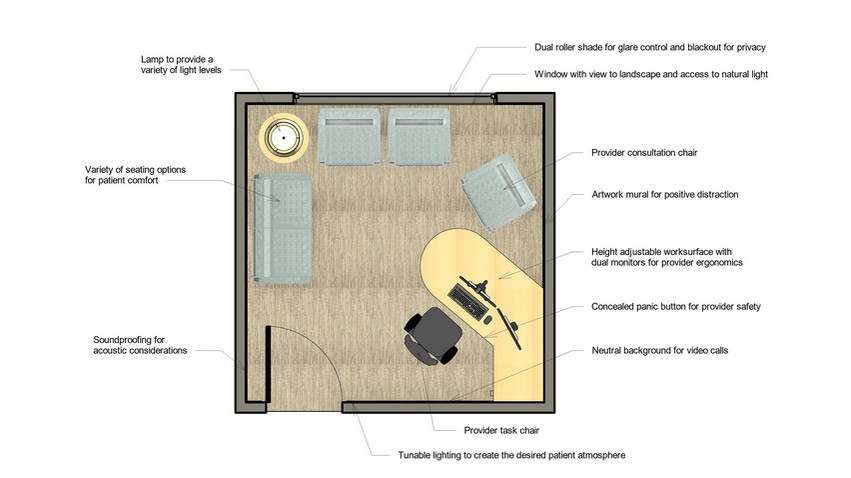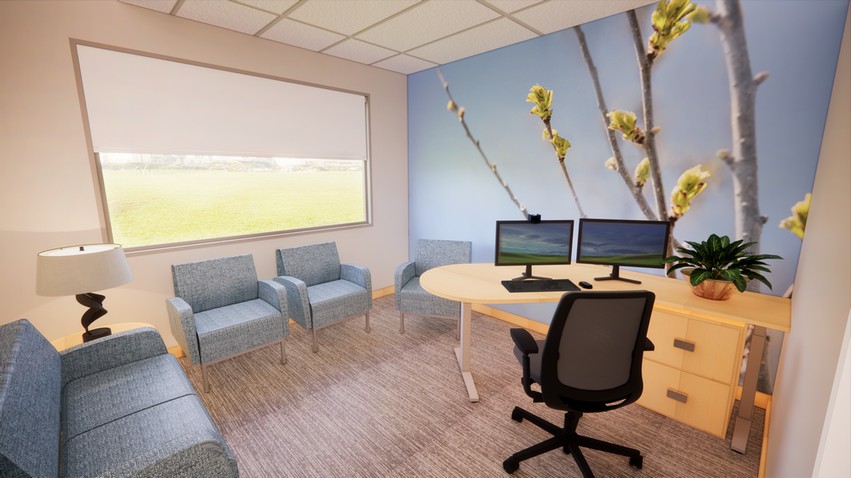 Telehealth room layout.
Telehealth room layout.  Rendering of a typical behavioral health consultation room. Rendering provided by JLG Architects.
Rendering of a typical behavioral health consultation room. Rendering provided by JLG Architects. Subscribe Now
Virtually Confronting the Behavioral & Mental Health Crisis
By Todd Medd and Kristine Sallee
The influence of telehealth and the built environment in today’s mental healthcare climate
In 2021, on the first day of February, my family of four became a family of three. Liam, my 15-year-old son, had the world at his feet; a great student, boy scout, multi-sport athlete, kind friend, leader, amazing big brother and an energetic soul. Despite the endless list of reasons to love his life, he made the decision to end it. As grieving parents, my wife and I searched for rationale, but unfortunately, he had never shown the telltale signs of a mental health struggle. Slowly, we transitioned from being Liam’s No. 1 fans in the stands to standing in front of our community, bracing ourselves to speak out on behalf of other parents and silenced students. As a dad, I am driven to honor my son by breaking the stigma of silence, while as a healthcare practice studio leader at JLG Architects, I am seeking solutions that pave the way for a more accessible built and virtual mental health environment.
Alongside my colleague and healthcare interior designer, Kristine Sallee, we are working to identify solutions to bridge the gap between silence and seeking help. When hybrid models of in-person and telehealth care emerged as a mainstay in mental and behavioral healthcare models, it was our cue to explore ways to give virtual reality a brick-and-mortar home where all patients feel heard, respected and welcomed.
Virtual reality
It’s undeniable that mental and behavioral healthcare providers have faced a rough two years of increasing demand that isn’t slowing down. According to Healthy Minds NCHA COVID-19 survey, 4 in 10 adults in the United States had anxiety or depressive disorder during the pandemic, compared to 1 in 10 adults before the pandemic. In addition, 26% of young adults (age 18-24) reported suicidal thoughts compared to 11% of all adults. There are a multitude of emerging solutions and ideas within the wake of COVID-19, but there is one area that has garnered more immediate attention: telehealth.
With regional healthcare leaders claiming virtual health and telemedicine are here to stay, it’s time to define how telehealth pathways can influence mental healthcare, who is seeing the most benefit and how we can work to create built environments that complement this new reality.
Perspective + positive change
To gain a clearer perspective of telehealth in mental and behavioral health systems, Kristine and I approached some of the healthcare industry’s top experts from across the Midwest. Our invitation was for an open, transparent discussion that would help us to truly understand the delivery of care from inside the system. This resulted in riveting conversations with Joseph Clubb, MSW LICSW, Allina Health’s vice president of operations in mental health & addiction services, as well as Heather Siek, Psy.D., LPCC and Kathryn Davis Tidd, MSW, LICSW of The Village Family Service Center; Kurt Smith, corporate construction manager at Hazelden Betty Ford and Kristin Roman Rehkamp of PrairieCare’s board of directors.
Outpatient in-person care vs. outpatient telehealth care
Through research and discussion, we gained both patient and provider views in relation to convenience factors that only telehealth can provide, such as eliminating the stress of traffic, parking, time away from work, coordinating childcare and privacy. For some, Joseph Clubb at Allina Health noted, just being in the comfort of their own home has helped patients open up to their care provider, essentially putting them on the path to a better health outcome. PrairieCare’s Rehkamp found a similar scenario – noting that patients who were too traumatized by the inpatient mental health system to enter another healthcare building for outpatient therapy, have reaped the benefits of virtual visits and the comfort, security and familiarity of being in their own environment.
For the sake of patients’ privacy and anonymity, many in behavioral health are seeing the benefit in adopting a more permanent hybrid model of care. According to Clubb, their clinical need and preference has since adapted to one-third of their employees working from home, one-third hybrid and the remaining staff choosing all in-person. In response, customer satisfaction with virtual care at Allina Health has increased from 35% to 75% over the course of the pandemic – possibly in relation to the quicker access to specialists and decreased stimulation of in-person visits.
Telehealth’s impact on providers
The rising demand and integration of telehealth technology has taken a toll on providers, especially essential workers and those caring for patients admitted for substance abuse, suicide, depression, anxiety and drug overdose. If we want to work alongside today’s healthcare systems, the stakes are higher, requiring both built and virtual pathways that will more efficiently treat patients, while creating a more humane and empathetic environment for healthcare staff.
Allina Health has adapted by reducing telehealth workdays to five-hour shifts to keep provider screen time in line with a more manageable workday. They are also one of the many healthcare leaders working to redesign the built environment to better connect patients to care providers, create respite and meditation rooms and design spaces with biophilic elements – aiming to offset the stress of a hybrid workday. The Village Family Service Center in Moorhead, Minnesota has also noticed provider fatigue and exhaustion related to back-to-back scheduling of telehealth sessions. While some providers recharge with a mid-week day designated as in-person only, others have requested more time between appointments to recalibrate.
Offsetting the challenges
To offset the challenges, we explored ages and types of patients that are having the highest success rate with virtual visits. According to Smith at Hazelden Betty Ford Foundation, one-to-one mental health counseling is the most successful virtual visit. They’ve also noticed that group and pediatric visits have not been as successful due to technology failure, background noise, patients forgetting to mute/unmute themselves and environmental distractions. Siek and Davis Tidd, at The Village Family Service Center, also confirmed that telehealth has been a challenge, specifically with elementary age children and younger patients who require play therapy. Additionally, they noted a challenge with male patients who tend to prefer side-by-side, walk and talk or activity-based interactions versus face-to-face.
While both practices have experienced the benefits of telehealth, Davis Tidd and Siek feel telehealth therapy is best utilized with an already established in-person relationship. Their concerns stem from privacy for clients in their own home, especially if there is a history of abuse. In a virtual environment, therapists cannot easily recognize subtle body cues, body language or changes in tension or eye contact. While telehealth has been beneficial to them in reaching transitional and rural patients, it has been conflicting for social anxiety patients. Telehealth provides comfort for patients who experience high anxiety in leaving their homes, but it can also hinder their long-term progress. Davis Tidd and Siek consider interaction within a therapist’s office to be part of the “ritual of care.”
Telehealth as a solution
According to PrairieCare’s CEO Todd Archbold, LSW MBA, over 1 million Minnesotans are experiencing symptoms of a mental illness – translating to almost one out of every five people. Unfortunately, it’s estimated that less than half of these individuals will seek help, either virtual or in-person. With rapid advancements at our fingertips, this number could change dramatically, with an overwhelming benefit to mental and behavioral health patients. We are working within many Midwest systems to adopt a more permanent, hybrid model of care. Here are just a few guidelines to help streamline the provider and patient experience.
|
Design with focus on natural elements like daylight, plants, water and exposed wood. Nature has also been known to reduce stress and anxiety, lower blood pressure, accelerate healing and provide pain relief, as reported in an array of studies around the globe.
Virtual design vs. the built environment
Does the stronghold of telehealth mean the built environment is losing its footing? The short answer is no. If anything, the emergence of telehealth is helping the built environment gain ground, but with an entirely new and more welcoming perspective – empowering the patient with more choices for care that inch toward ending the silence.
While telehealth may be the gentle portal to in-person patient care for some, the patients who prefer in-person care have set a new standard. We are now living in a climate that readily embraces telehealth, as well as human-centric environments and sensory-sensitive design. When the pandemic forced us out of buildings, patients came back with higher physical expectations, a desire for better wayfinding and requests for less stressful and more immediate access. Today’s patient is seeking a warmer, re-envisioned healthcare setting with the comfort of amenities that altogether create a destination worth visiting.
Empowering environments
In January, I was designing for mental healthcare systems, and today, my family is immersed in the infrastructure, working toward relief from our own trauma, grief and anxiety. Overall, I’m grateful to have a platform for positive change, through my career and community. Through our dedicated healthcare studio, Kristine and I have the opportunity to work with clients, partners and consultants to transform my family’s tragedy into another family’s triumph. My ultimate hope for these families is that the advancements we make in both the professional realm, and personal outreach, will open the door to simplified access to mental health treatments and solutions, without having to experience the devastating aftermath of silence.
To further extend our outreach, my family and I have formed the 4-6-3 Foundation with Dakota Medical Foundation in Fargo, North Dakota, helping to empower other families and teens with mental health struggles. Our quest is to keep the conversation going, reduce the stigma, build hope and end suicide – starting within our own community, schools and healthcare systems.
Click here for more information about the 4-6-3 Foundation.
Author: Todd Medd and Kristine Sallee
Todd Medd is a principal architect, healthcare practice studio leader and a passionate healthcare thought leader at JLG Architects.
Kristine Sallee is a healthcare designer and client relationship manager at JLG Architects, certified interior designer, LEED AP, WELL AP and Evidence-Based Design Accredited Professional.
Tags: Architecture, behavioral health, Mental Health, Telehealth, Virtual Reality
Posted January 17, 2022
More Articles:
- Coverings 2024
Apr 22, 2024 – Apr 25, 2024 - Hospital, Outpatient Facilities & Medical Office Buildings Summit
Apr 25, 2024 – Apr 25, 2024 - CxA Workshop & Exam
Apr 29, 2024 – Apr 30, 2024 - EMP Seminar & Exam at CxEnergy 2024
Apr 29, 2024 – Apr 30, 2024 - CxEnergy
Apr 29, 2024 – May 2, 2024 - PHCC West 2024
Apr 29, 2024 – May 2, 2024 - Lean in Design Forum 2024
May 1, 2024 – May 2, 2024










